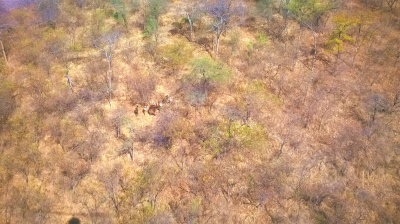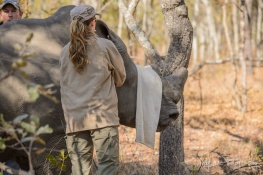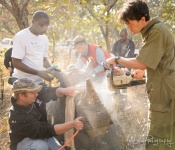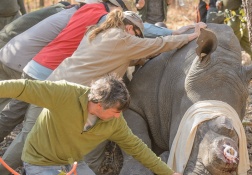|

The rotor blades of the helicopter slapped the warm afternoon air, drowning out any extraneous sounds. As the chopper hugged the steep slope of a hill to the right, I craned my neck out of its open front left seat and scoured the dense vegetation in the river bed on my left below. “I don’t see him! Where is he?” I shouted through the radio to N-J, the pilot. “We’re right above him!” N-J said. I shifted my perspective and looked straight down through the chopper’s skids. Two thirds of the way up the hill already, the massive grey shape had come to a standstill. “S#%t!! Could he have chosen a steeper hill?” We knew the terrain was going to be challenging, and our scratched and bruised bodies already bore testament to that fact. But, looking at this incline – “Geez, give us a break!”
The black rhino bull below was something of a legend. He was the one the team had been most anxious to de-horn. As yet untouched by human hands, this beautiful male had managed over the years to evade any previous attempts to capture him for de-horning or ear notching. Some of the rangers believed he was protected by ancestral spirits and the protection needed to be temporarily removed by a n’anga before he could be darted to acquire the protection that de-horning might provide. He was certainly a prime target for poachers. We were now on day 13 of a two week operation and time was running out.
The spotter pilot, Martin, in the Supercub aircraft overhead had been directed to his general area by the scouts who had been tracking the rhino’s spoor all day. There he had glimpsed the dark shadow of the rhino’s perfect horns silhouetted against the tawny ground in the long afternoon light. Martin’s unusually animated voice crackled through the radio to the vet team. “OK! Got him visual! And this one’s got Horns!”
We had been in a state of suspended alert the whole day with no action. Now the adrenaline levels started climbing as we quickly jumped into our seats in the chopper. N-J cranked the engine. It sputtered and died. The magnetos had been giving some trouble for a few days now. He tried again. No joy. On the third attempt the engine backfired. N-J put his hands behind his head and looked skywards. For a tense moment it looked like maybe the rangers were right, perhaps this rhino would forever evade being caught. Then he tried again, and the engine sputtered into life.
 N-J quickly had us airborne, and dropped me off in a rocky riverbed within a kilometer of the rhino’s loc-stat. The terrain here is so unforgiving that it is almost impossible to manoeuvre the R44 helicopter just meters above the tree canopy into opportunistic darting positions with the weight of an extra person in the passenger seat, which is why all the darting was done “one-up”. The other serious drawback is that the area is so densely vegetated that “L-Zed’s” (landing zones) for the helicopter – which require a clear diameter of at least 13 meters for the chopper to set down – are few and far between, and dry river beds often provide the most suitable clearings. This means that the vets are sometimes set down more than five hundred meters from where the rhino goes down, necessitating a high level of fitness to get in to the rhino quickly with the essential equipment that could get the animal out of trouble. Preparation is everything. The lack of road access also means that the ground crew – so useful in the more open white rhino areas - rarely makes it in to the black rhino, which puts an extra burden on the chopper team to bring everything necessary in to each animal. On occasion the chopper pilot would have to pick up ground team members and ferry them in to the L-Z nearest the rhino to bring in extra water sprayers or such like. N-J quickly had us airborne, and dropped me off in a rocky riverbed within a kilometer of the rhino’s loc-stat. The terrain here is so unforgiving that it is almost impossible to manoeuvre the R44 helicopter just meters above the tree canopy into opportunistic darting positions with the weight of an extra person in the passenger seat, which is why all the darting was done “one-up”. The other serious drawback is that the area is so densely vegetated that “L-Zed’s” (landing zones) for the helicopter – which require a clear diameter of at least 13 meters for the chopper to set down – are few and far between, and dry river beds often provide the most suitable clearings. This means that the vets are sometimes set down more than five hundred meters from where the rhino goes down, necessitating a high level of fitness to get in to the rhino quickly with the essential equipment that could get the animal out of trouble. Preparation is everything. The lack of road access also means that the ground crew – so useful in the more open white rhino areas - rarely makes it in to the black rhino, which puts an extra burden on the chopper team to bring everything necessary in to each animal. On occasion the chopper pilot would have to pick up ground team members and ferry them in to the L-Z nearest the rhino to bring in extra water sprayers or such like.
The helicopter located the bull in some scrubby bush at the confluence of two river valleys, each lined by some impressive mountains. “OK, got him visual, thanks Martin” N-J transmitted. The cunning rhino tried to avoid the impending dart by running in a circle beneath the chopper, putting N-J’s incredible flying skills to the ultimate test. Fortunately Keith was swift and accurate and the dart hit the rhino's rump before he could disappear into the tree canopy again. I crouched on the river bed anxiously listening to the comms between the two pilots. “OK. We’ve got a dart in”, NJ said. Further narrative from the fixed wing ensued. “He’s running upstream now….He’s crossed the river now…He’s going uphill now…Yup he’s showing sign”. Once the animal started showing signs of the sedation, N-J set Keith down as close as he could to the rhino and came back to collect me while Martin kept a watchful eye. We hovered directly above the rhino for ten seconds or so in order to provide a directional beacon for Keith who was still making his way up the hill and in to the rhino. I steeled myself for the climb ahead. Then N-J dropped me off in the river bed with my spare drug bag and asked Martin to talk me in while he went back to collect Anton and a water sprayer.
It’s surprising how quickly you can lose your sense of direction once you’re on the ground surrounded by thick bush. “Turn right now Lisa” I heard Martin say as I blundered forward over the bed of smooth river boulders. “Where, for $%%##’sake!” as I realized the twelve foot climb out of the river bed was almost vertical. Somehow the adrenaline propelled me upwards and I managed to clamber out of the river with the help of some thorny branches. The gradient up to the rhino was almost steep enough to use my hands as well as my feet to climb. By the time I reached Keith my quads were burning and I was red-lining, and therefore was extremely relieved to find that the rhino had gone down with his head up the hill, so there was no extra pressure from his body on his diaphragm. I think the spirits were protecting him after all – looking down the slope he could have easily slid or rolled into an awkward position. The pulse oximeter readings were stable and the medical oxygen was flowing in nicely.  After a few deep breaths – just long enough to admire this gorgeous creature, I cross checked the rhino’s pulse rate with the pulse oximeter, and measured his respiration as Keith measured and marked the horn. Whilst Keith started up the chainsaw, I attached haemostats onto the rhino's virgin ears in order to place his identification notches. He was lying in lateral recumbency squashing his lower ear which made the notching of his lower ear difficult, but there was no way the two of us could move this 1200kg behemoth on this dangerous slope. Once the notching was done, we inserted microchips behind his left ear and on his left forehead as standard. This is to aid in the identification of a degraded carcass should the animal be poached in the future. Blood samples were taken, and at this point a breathless Anton and two delighted rangers, Gerald and Freeman – the ones who had been tracking his spoor – arrived with the water sprayer. The animal was doused to cool him down and finally painted so he could be easily identified from the air. The horn and all the horn shavings were collected in a tough plastic bag for hand over to the Area Manager. After a few deep breaths – just long enough to admire this gorgeous creature, I cross checked the rhino’s pulse rate with the pulse oximeter, and measured his respiration as Keith measured and marked the horn. Whilst Keith started up the chainsaw, I attached haemostats onto the rhino's virgin ears in order to place his identification notches. He was lying in lateral recumbency squashing his lower ear which made the notching of his lower ear difficult, but there was no way the two of us could move this 1200kg behemoth on this dangerous slope. Once the notching was done, we inserted microchips behind his left ear and on his left forehead as standard. This is to aid in the identification of a degraded carcass should the animal be poached in the future. Blood samples were taken, and at this point a breathless Anton and two delighted rangers, Gerald and Freeman – the ones who had been tracking his spoor – arrived with the water sprayer. The animal was doused to cool him down and finally painted so he could be easily identified from the air. The horn and all the horn shavings were collected in a tough plastic bag for hand over to the Area Manager.
Without wasting any further time, the reversal drug was drawn up and we all selected our own nearby tree to climb. Black rhino can be extremely aggressive and will quite often erupt in a fury and beat down anything in their path as they wake up. Keith administered the injection into his ear vein and removed the blindfolds and ear muffs. We watched for a minute as the rhino’s breathing became deeper and his ears flicked forward. For the first time in the op, I felt a deep sadness that we have to invade these creatures’ lives in such a way in order to try and protect them. And an absolute hatred for all those responsible for the atrocities being committed against our wildlife.
Seconds later he was up, engaging four wheel drive as he powered his hulk of a body further up towards the top of the hill. With a mixture of triumph and a heavy heart, we hoisted our kit onto our backs and started picking our way down the hill towards the helicopter.
In a two week period in July, AWARE performed its most comprehensive rhino de-horning operations in partnership with PWMA to date, de-horning just under 40 animals in various National Parks Estates throughout the country. We will be posting more pictures on our facebook page. Since consistent and comprehensive de-horning progammes were instituted in 2010 in the areas that AWARE supports, no white rhinos have been lost to poaching, and only one black rhino has been lost to confirmed poaching. Comprehensively de-horning all the rhinos in an area reduces the reward:risk ratio for a potential poacher and therefore acts as a deterrent. De-horning, in combination with increased security, ranger training and support of rangers, can be an effective measure against poaching.
    
Parks’ rangers are on the frontline of the war against rhinos and need your support. They perform a difficult and dangerous job and we were extremely impressed with their hard work and bush skills during our operations. We would like to supply one station with a consistent supply of monthly rations. If you can help by supplying monthly mielie meal, beans, fish, oil, salt, sugar, tea, milk powder, etc. please contact tracey@awaretrust.org.
As the AWARE Team reflect on the enormity of the operations they have just carried out to protect Zimbabwe’s precious rhino, we would like to acknowledge all those people who helped to make it possible. Logistics to de-horn rhinos in such numbers can be daunting! We extend our sincere thanks to all of you:
Anton Newall
Nick La Grange
Tracey and Chris Hugill
Save African Rhino Foundation
Brian Rodgers and Daniel, Lizzie, Eddie and Manny
Tim Fennel and Tanganda
Shaun Torr and Oxpecker Cleaning Systems
Martin Henriksen and Executive Air
PWMA
Toni Mckey
Big Sky and Sean Quinlan
Spar Borrowdale
Friends of Kyle and Nyaradzo
BOC Gases
Sawpower - Greg and Ralph Stead
Andy Lowe Photography
Cheeseman
Liz Small, Lorraine Reynolds and Controlled Hygiene Services
Billy’s Meats
All who donated funds towards operations. Apologies for any we have not mentioned.
|